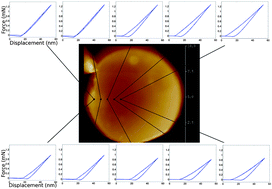Due to its remarkable mechanical and biological properties, there is considerable interest in understanding, and replicating, spider silk's stress-processing mechanisms and structure-function relationships. Here, we investigate the role of water in the nanoscale mechanics of the different regions in the spider silk fibre, and their relative contributions to stress processing. We propose that the inner core region, rich in spidroin II, retains water due to its inherent disorder, thereby providing a mechanism to dissipate energy as it breaks a sacrificial amide-water bond and gains order under strain, forming a stronger amide-amide bond. The spidroin I-rich outer core is more ordered under ambient conditions and is inherently stiffer and stronger, yet does not on its own provide high toughness. The markedly different interactions of the two proteins with water, and their distribution across the fibre, produce a stiffness differential and provide a balance between stiffness, strength and toughness under ambient conditions. Under wet conditions, this balance is destroyed as the stiff outer core material reverts to the behaviour of the inner core.

You have access to this article
 Please wait while we load your content...
Something went wrong. Try again?
Please wait while we load your content...
Something went wrong. Try again?


 Please wait while we load your content...
Please wait while we load your content...